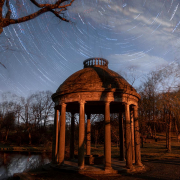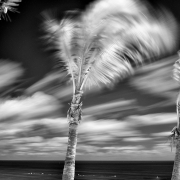Glimpsed Actualities
Ever wonder if you are missing something when looking at a scene? I’m not talking about missing “the shot”, I’m talking about the imperceptible.
We humans have pretty limited eyesight. We see a slim sliver of the electromagnetic spectrum called the visible spectrum. We don’t see well in the dark and our colorful daytime vision becomes monochromatic at night. It is this limitation that fascinates me. Those that are familiar with my photography know I am focused (okay, call it obsessed) on capturing starry skies, infrared, and time-lapse photography. For the past 4 years or so I have been combining these three loves, shooting time-lapses of night scenes simultaneously with a normal camera and infrared camera.

The tiny slice of the electromagnetic spectrum between UV and IR is what our eyes can actually discern.
Digital cameras are fantastic at capturing the colors of the night. If we are lucky to see the Milky Way with the naked eye, it appears to be a band of hazy white across the sky, hence the moniker “Milky Way”. Because our night vision is monochromatic, we are unable to see the amazing color that is present. To us, the night is colorless. We are able to notice the color of the planet Mars (red), and some stars, like Betelgeuse (red) and Rigel (blue) which are supergiant stars in the constellation Orion, but for the most part, we can’t pick up the colors of the stars at night. A digital camera can see this color and it captures it splendidly.
Although infrared cameras are mostly used during the daylight hours, they can see very well at night. Infrared has been used in astronomy for decades because it cuts through haze and picks up elements that are invisible to us and also to a normal camera. Infrared can also cut through light pollution pretty well. I can capture the galactic core of the Milky Way in areas where my normal camera cannot see it. Read more about infrared at night.
The following time-lapse is comprised of two sequences, one photographed with a normal camera, and the other with an infrared camera. The scene was shot simultaneously with both cameras. The night was clear yet infrared exposes it to be anything but. To my eyes, the night was clear and dark, the Milky Way faint and monochromatic. Both cameras illuminated the shortcomings of my paltry eyesight.
Nikon D780 |14-24mm | f/2.8 | ISO 3200 ||| Nikon D800 Full-spectrum @ 720 nm |17-35mm| f/2.8 | ISO 6400
Time-lapse brought forth the movement of the Earth, revealing the Milky Way traversing the sky. Time-lapse is incredibly powerful. It lets us see changes otherwise indiscernible. It compresses time so minute changes are now observable. In both sequences, time-lapse captures fireflies flitting in the grass, and brings your eye to the water reflection made by Jupiter moving across the sky. Yes, planets reflect on the water here on Earth. How cool is that?! More on time-lapse photography.
To be clear, digital cameras do not yet have the same dynamic range our eyes have. However, their ability to capture the night and wavelengths past the visible spectrum allows us to see what we can’t naturally.
What are your thoughts about our limited eyesight and our powerful cameras? How do you use your camera to see what your eyes naturally can’t?
Let’s hear it in the comments or drop me a line. I’d love to hear about it.
#art #photographer #photo #photography #experience #gear #passion #inspiration
© Silvana Della Camera


 Silvana Della Camera
Silvana Della Camera
 Silvana Della Camera
Silvana Della Camera Silvana Della Camera
Silvana Della Camera



Leave a Reply
Want to join the discussion?Feel free to contribute!